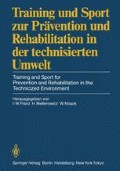Zusammenfassung
Der Begriff (absolutes) kritisches Herzgewicht wurde von Linzbach u. a. anhand von Sektionen verstorbener Sportler aufgestellt und bei 500 g angenommen. Eine mögliche körpergewichtsbezogene bzw. oberflächenbezogene Abhängigkeit wurde nicht untersucht. Deshalb wurde bei 32 Untrainierten (U), 66 z. T. extrem Ausdauertrainierten (AT), 10 Kraftsportlern (KS), 30 Hypertonikern, (HT), 20 Patienten mit HOCM, 10 Patienten mit dilatativer Kardiomyopathie (DKM) sowie 10 Patienten mit Aorteninsuffizienz (AI) zweidimensional echokardiographisch nach einer modifizierten Simpson rule (2 Querachsen, 2- und 4-Kammerblick) die linksventrikuläre Muskelmasse (LVM), das enddiastolische Volumen (EDV) und die Ejektionsfraktion (EF) sowie das röntgenologische Herzvolumen (HV) bestimmt.
Bezogen auf das Körpergewicht ändern sich LVM, EDV und EF bei Kraftsportlern nicht, bei Ausdauersportlern ist bei maximaler Herzvergrößerung (HV/kg = 19 ml/kg) LVM um 75%, EDV um 55% gegenüber vergleichbaren U vergrößert, EF ist gleich. Bei Erreichen dieses körpergewichtsbezogenen Grenzwertes ist bei Hypertonikern bereits in 65% bei HOCM in 15%, AI in 10% und bei DKM in allen Fällen die EF vermindert.
Ein absoluter kritischer Grenzwert der physiologischen Hypertrophie ist nicht ableitbar, jedoch ein relativer Grenzwert (7,5 g/kg). Bei Patienten mit Hypertonie, HOCM und DKM ist ein Zusammenhang mit dem Überschreiten eines physiologischen Grenzwertes und der Verschlechterung der linksventrikulären Funktion nicht erkennbar, für volumenbelastete Herzen scheint dies möglich.
Summary
The term (absolute) critical heart weight was introduced by Linzbach following post mortems of patients with hypertrophy and of athletes and is thought to be 500 g. The dependence of this value on body weight or surface area was not investigated. Therefore echocardiographic examinations were carried out on 32 untrained persons (U), 66 endurance trained athletes (AT), 10 power trained athletes, 30 patients with hypertony (HT), 20 patients with HOCM, 10 patients with dilatative cardiomyopathy (DKM) and 10 patients with aortic insufficiency (AI), following a modification of a Simpson’s rule (two short axis, 2- and 4-chamber view). The left ventricular muscle mass (LVM), the end diastolic volume (EDV), and the ejection fraction (EF) were calculated, the heart volume (HV) was estimated by x-ray.
LVM, EDV and EF did not change in relation to the body weight in power trained athletes. In endurance trained athletes with a maximum heart volume (19 ml/kg), LVM is increased by 75% and EDV by 55% as compared to untrained subjects, EF remains constant. When this critical physiological heart weight (LVM/kg) is reached or passed then EF is already in 65% of the HT cases in 15% of the HOCM cases, in 10% of the patients with AI and in all patients with dilatative cardiomyopathy decreased.
An absolute critical heart weight for a physiological hypertrophy cannot be determined, however a relative critical heart weight (7,5 g/kg) can. In patients with hypertension HOCM, and DKM this relative critical heart weight appears to be of no clinical relevance. However, in hearts under volume stress, this value may be of importance.
Mit Unterstützung des Bundesinstituts für Sportwissenschaft Köln-Lövenich
Access this chapter
Tax calculation will be finalised at checkout
Purchases are for personal use only
Preview
Unable to display preview. Download preview PDF.
Literatur
Adler CP, Sandritter W (1971) Numerische Hyperplasie der Herzmuskelzellen by Hypertrophie. Dtsch Med Wschr 96: 1895
Dickhuth H-H, Nause A, Staiger J, Bonzel T, Keul J (1983) Two-dimensional echocardiographic measurements of left ventricular volume and stroke volume of endurance-trained athletes and untrained subjects. Int J Sports Med 4: 21
Dickhuth H-H, Simon G, Kindermann W, Wildberg A, Keul J (1979) Echokardiographische Untersuchungen bei Sportlern verschiedener Sportarten und Untrainierten. Z Kardiol 68: 449
Devereux RB, Reicheck N (1977) Echocardiographic determination of left ventricular mass in man. Circulation 55: 613
Helak JW, Reichek N (1981) Quantitation of human left ventricular mass and volume by two-dimensional echocardiography. In vitro Anatomic Validation. Circulation 63: 1398
Hort W (1953) Quantitative histologische Untersuchungen an wachsenden Herzen. Virchows Arch path Anat 323: 223
Keul J, Dickhuth H-H, Simon G, Lehmann M (1981) Effect of static and dynamic exercise on heart volume, contractility and diameter of ventricular wall and volume. Circulation research 48: 6
Linzbach AJ (1948) Herzhypertrophie und kritisches Herzgewicht. Klin Wochenschr 26: 459
Morganroth J, Maron BJ, Henry WL, Epstein SE (1975) Comparative left ventricular dimensions in trained athletes. Ann Intern Med 82: 521
Reiner L, Mazzoleni A (1959) The weight of the human heart in normal cases. Arch Pathol 68: 68
Schoenmackers J (1958) Vergleichende quantitative Untersuchungen über den Faserbestand des Herzens bei Herz-und Herzklappenfehlern sowie Hochdruck. Virchows Arch Pathol Anat 331: 3
Author information
Authors and Affiliations
Editor information
Editors and Affiliations
Rights and permissions
Copyright information
© 1985 Springer-Verlag Berlin Heidelberg
About this chapter
Cite this chapter
Dickhuth, HH., Jakob, E., Wink, K., Bonzel, T., Keul, J., Just, H. (1985). Läßt sich aus der maximalen physiologischen Herzhypertrophie ein absolutes kritisches Herzgewicht ableiten?. In: Franz, IW., Mellerowicz, H., Noack, W. (eds) Training und Sport zur Prävention und Rehabilitation in der technisierten Umwelt / Training and Sport for Prevention and Rehabilitation in the Technicized Environment. Springer, Berlin, Heidelberg. https://doi.org/10.1007/978-3-642-70301-0_114
Download citation
DOI: https://doi.org/10.1007/978-3-642-70301-0_114
Publisher Name: Springer, Berlin, Heidelberg
Print ISBN: 978-3-642-70302-7
Online ISBN: 978-3-642-70301-0
eBook Packages: Springer Book Archive

